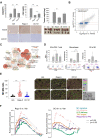Regorafenib enhances antitumor immunity via inhibition of p38 kinase/Creb1/Klf4 axis in tumor-associated macrophages
- PMID: 33753566
- PMCID: PMC7986673
- DOI: 10.1136/jitc-2020-001657
Regorafenib enhances antitumor immunity via inhibition of p38 kinase/Creb1/Klf4 axis in tumor-associated macrophages
Abstract
Background: Regorafenib and other multikinase inhibitors may enhance antitumor efficacy of anti-program cell death-1 (anti-PD1) therapy in hepatocellular carcinoma (HCC). Its immunomodulatory effects, besides anti-angiogenesis, were not clearly defined.
Methods: In vivo antitumor efficacy was tested in multiple syngeneic liver cancer models. Murine bone marrow-derived macrophages (BMDMs) were tested in vitro for modulation of polarization by regorafenib and activation of cocultured T cells. Markers of M1/M2 polarization were measured by quantitative reverse transcription PCR (RT-PCR), arginase activity, flow cytometry, and ELISA. Knockdown of p38 kinase and downstream Creb1/Klf4 signaling on macrophage polarization were confirmed by using knockdown of the upstream MAPK14 kinase, chemical p38 kinase inhibitor, and chromatin immunoprecipitation.
Results: Regorafenib (5 mg/kg/day, corresponding to about half of human clinical dosage) inhibited tumor growth and angiogenesis in vivo similarly to DC-101 (anti-VEGFR2 antibody) but produced higher T cell activation and M1 macrophage polarization, increased the ratio of M1/M2 polarized BMDMs and proliferation/activation of cocultured T cells in vitro, indicating angiogenesis-independent immunomodulatory effects. Suppression of p38 kinase phosphorylation and downstream Creb1/Klf4 activity in BMDMs by regorafenib reversed M2 polarization. Regorafenib enhanced antitumor efficacy of adoptively transferred antigen-specific T cells. Synergistic antitumor efficacy between regorafenib and anti-PD1 was associated with multiple immune-related pathways in the tumor microenvironment.
Conclusion: Regorafenib may enhance antitumor immunity through modulation of macrophage polarization, independent of its anti-angiogenic effects. Optimization of regorafenib dosage for rational design of combination therapy regimen may improve the therapeutic index in the clinic.
Keywords: immunomodulation; immunotherapy; tumor microenvironment.
© Author(s) (or their employer(s)) 2021. Re-use permitted under CC BY. Published by BMJ.
Conflict of interest statement
Competing interests: Dr A-L Cheng is a consultant for and a member of the speaker’s bureau of Bayer-Schering Pharma. Dr A-L Cheng is a consultant of Novartis, Merck Serono, Eisai, Merck Sharp & Dohme (MSD) Corp., ONXEO, Bayer HealthCare Pharmaceuticals Inc., Bristol-Myers Squibb (BMS) Company, and Ono Pharmaceutical Co., Ltd. Dr C Hsu received research grants from BMS/ONO, Roche, and Ipsen and received honorarium from the following pharmaceutical companies: AstraZeneca, Bayer, BMS/ONO, Eisai, Eli Lilly, Ipsen, Merck Serono, MSD, Novartis, Roche, and TTY Biopharm.
Figures






Similar articles
-
Regorafenib combined with PD1 blockade increases CD8 T-cell infiltration by inducing CXCL10 expression in hepatocellular carcinoma.J Immunother Cancer. 2020 Nov;8(2):e001435. doi: 10.1136/jitc-2020-001435. J Immunother Cancer. 2020. PMID: 33234602 Free PMC article.
-
Immunomodulatory Effects of Current Targeted Therapies on Hepatocellular Carcinoma: Implication for the Future of Immunotherapy.Semin Liver Dis. 2018 Nov;38(4):379-388. doi: 10.1055/s-0038-1673621. Epub 2018 Oct 24. Semin Liver Dis. 2018. PMID: 30357775
-
Regorafenib enhances M1/M2 macrophage polarization by inhibiting the secretion of plasminogen activator inhibitor-1 in head and neck squamous cell carcinoma.Life Sci. 2024 Dec 1;358:123147. doi: 10.1016/j.lfs.2024.123147. Epub 2024 Oct 15. Life Sci. 2024. PMID: 39419267
-
Tramadol suppresses growth of orthotopic liver tumors via promoting M1 macrophage polarization in the tumor microenvironment.Naunyn Schmiedebergs Arch Pharmacol. 2024 Jun;397(6):4205-4218. doi: 10.1007/s00210-023-02871-1. Epub 2023 Dec 2. Naunyn Schmiedebergs Arch Pharmacol. 2024. PMID: 38041778
-
Role of cellular, molecular and tumor microenvironment in hepatocellular carcinoma: Possible targets and future directions in the regorafenib era.Int J Cancer. 2020 Oct 1;147(7):1778-1792. doi: 10.1002/ijc.32970. Epub 2020 Apr 15. Int J Cancer. 2020. PMID: 32162677 Review.
Cited by
-
Translational research on drug development and biomarker discovery for hepatocellular carcinoma.J Biomed Sci. 2024 Feb 17;31(1):22. doi: 10.1186/s12929-024-01011-y. J Biomed Sci. 2024. PMID: 38368324 Free PMC article. Review.
-
RIFLE: a Phase II trial of stereotactic ablative radiotherapy combined with fruquintinib and tislelizumab in metastatic colorectal cancer.Gastroenterol Rep (Oxf). 2023 Oct 11;11:goad063. doi: 10.1093/gastro/goad063. eCollection 2023. Gastroenterol Rep (Oxf). 2023. PMID: 37842200 Free PMC article.
-
Nanoparticle-mediated SIRT1 inhibition suppresses M2 macrophage polarization and hepatocarcinogenesis in chronic hepatitis B.J Nanobiotechnology. 2025 May 27;23(1):385. doi: 10.1186/s12951-025-03447-2. J Nanobiotechnology. 2025. PMID: 40426198 Free PMC article.
-
Clinical Application of Adaptive Immune Therapy in MSS Colorectal Cancer Patients.Front Immunol. 2021 Oct 13;12:762341. doi: 10.3389/fimmu.2021.762341. eCollection 2021. Front Immunol. 2021. PMID: 34721435 Free PMC article. Review.
-
Immune-Checkpoint Inhibitors for Metastatic Colorectal Cancer: A Systematic Review of Clinical Outcomes.Cancers (Basel). 2021 Aug 27;13(17):4345. doi: 10.3390/cancers13174345. Cancers (Basel). 2021. PMID: 34503155 Free PMC article. Review.
References
Publication types
MeSH terms
Substances
LinkOut - more resources
Full Text Sources
Other Literature Sources
Medical
Molecular Biology Databases
Miscellaneous
